In a demonstration of its rapid technological advancement, SpaceX has successfully launched batches of Starlink satellites, marking significant milestones in the company’s ambitious plan to provide global internet coverage. The most recent of these launches occurred over Memorial Day weekend, enhancing the operational efficiency of SpaceX’s satellite constellation and affirming its role as a leader in satellite internet solutions.
Significant Milestones: Falcon 9’s Achievements
On May 23, 2025, at 4:36 p.m. EDT, SpaceX launched its Starlink 11-16 mission from Vandenberg Space Force Base in California. The Falcon 9 rocket carried a payload of 23 satellites into low Earth orbit, marking the completion of the 450th successful booster landing attempt by SpaceX — an impressive feat demonstrating the company’s reliability and technological prowess.
“Falcon lands for the 450th time!” – SpaceX
The Falcon 9 rocket’s first-stage booster, designated B1075, had already supported 14 previous missions, showcasing its reusability and efficiency. After a journey of approximately 8.5 minutes post-launch, the booster successfully landed on the Of Course I Still Love You drone ship stationed in the Pacific Ocean.
The Role of Starlink in Global Connectivity
As part of SpaceX’s Starlink project, which boasts over 7,000 operational satellites, these missions serve to enhance the existing satellite network that delivers high-speed internet to underserved regions around the globe. Starlink aims to blanket the Earth with internet connectivity, especially in rural and remote areas.
Each new launch contributes to the ever-expanding Starlink megaconstellation, allowing users to establish internet connections virtually anywhere with proper receiver orientation. Customers can benefit from enhanced access while SpaceX continues to expand its operational capability through additional satellite deployments.
Further Launches and Future Plans
The recent successful launch marked the 61st Falcon 9 mission of 2025 and the total for the year has already reached 63 liftoffs. Alongside the Starlink launches, SpaceX is preparing for critical tests and subsequent missions involving the next-generation Starship rocket, indicating a busy year ahead in space exploration and satellite deployment.
One of the most anticipated tests involves Starship, aimed at providing much larger capacity for satellite deployment and paving the way for future missions to the Moon and Mars. SpaceX is poised to continue its journey of innovation in space travel, significantly impacting how society accesses internet connectivity.
Adapting Technology: Direct-to-Cell Capabilities
In a parallel development, a later Falcon 9 launch successfully deployed 23 more Starlink satellites, some of which have direct-to-cell capabilities. This advanced technology allows satellites to operate similarly to cell towers, enabling enhanced internet service integration for mobile devices. SpaceX and Starlink are redefining connectivity and pushing the envelope on traditional telecommunications.
According to Dr. Jonathan McDowell, a leading astrophysicist at Harvard-Smithsonian Center for Astrophysics, these satellites could change how users access mobile networks. The direct-to-cell feature will enable areas that have limited connectivity to establish robust communication channels through satellite-based internet.
Weather Challenges and Launch Conditions
Despite sometimes unfavorable weather conditions, the dedication of SpaceX’s engineering team has continued to shine through. Reports indicated a mere 20% to 40% chance of successful launch for the Falcon 9 due to weather concerns, yet the mission proceeded as planned. This resilience highlights the company’s ongoing commitment to pushing forward in the challenging realm of space exploration.
The Importance of Satellite Internet
As internet access becomes increasingly vital in daily life, satellite technology has emerged as a critical solution for global connectivity. Starlink is leading the way with its ability to reach individuals and businesses that were previously without reliable internet access.
Drawing on the ongoing advancements in rocket technology and satellite capabilities, SpaceX is not only addressing immediate connectivity concerns but is also setting the framework for a future where global internet service is ubiquitous and dependable.
Conclusion: A Future of Connectivity
With the latest batch of satellite launches, SpaceX is continuing to carve out its presence as a formidable player in the space frontier. As both the Falcon 9 and the Starlink network continue to evolve, consumers can expect more reliable and faster internet access, regardless of their location. The stars are indeed not the limit for SpaceX, but rather the beginning of a new era in global communications.
As SpaceX prepares for future milestones, it remains clear that innovation knows no bounds, and the drive towards connecting the entire world continues unabated.

